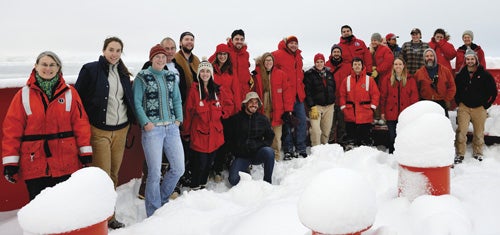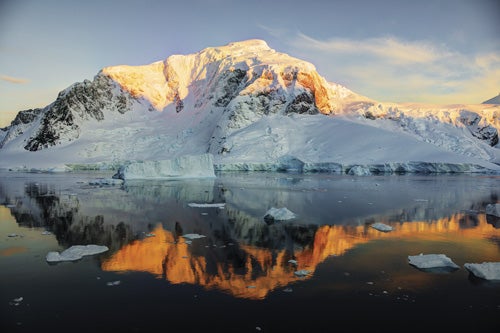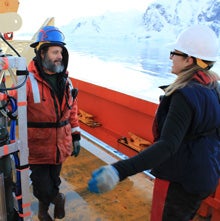The Thrill of the Krill
GSO’s venture into the icy waters of Antarctica
On May 13, 2013, 23 scientists set out from the southern tip of Chile, headed to the West Antarctic Peninsula, for a month-long cruise through the fjords of the coldest continent. Their mission, funded through the National Science Foundation’s Office of Polar Programs, was to learn more about Euphausia superba, or krill, as these tiny creatures are more commonly known.
The expedition was designed and led by four Graduate School of Oceanography (GSO) faculty members and Professor Meng Zhou from UMass Boston. From GSO scientists included Principal Investigator (P.I.) Professor Edward “Ted” Durbin along with Co-P.I.’s Professor Chris Roman and Professor Susanne Menden-Deuer, who also participated in the cruise, and Professor Tatiana Rynearson, who provided assistance with the research from land. Professors Bethany Jenkins (College of the Environment and Life Sciences) and Rebecca Robinson (GSO) also participated and provided crucial support. Additionally, nine URI-based graduate students, post-docs, and scientists played active roles in the research, and two URI undergraduate students, Michelle Dennis and Iain McCoy, were able to participate as volunteers.
Although krill are only about three to five centimeters long, they are vital to the ecosystem of Antarctica, making up 90 percent of the diet of the continent’s penguins and whales. But large gaps remain in our understanding of how the krill themselves survive, particularly during the winter season.
“A lot of scientists have been curious for years about what happens to krill in the wintertime and how they survive,” says Durbin. During the warmer months, krill eat phytoplankton, which are microscopic plants found in the water column. In the winter though, it is too dark for the plants to grow. What then do they eat?
“Given the food options on the menu,” explains Rynearson, “we’d like to know what the krill are eating and where they are eating it.” An expert in genetic analysis, she was able to provide crucial assistance in identifying prey present in krill guts and in comparing this to the potential prey items found in the krill’s environment, helping to piece together the puzzle of what the krill have eaten as well as the source of their food.
GSO Breeds Deans
A number of GSO alumni have served or continue to serve as deans in top research, academic, and training institutions around the world. Here are some examples of the GSO’s stellar alumni in dean positions today:
Bruce Corliss, M.S. ’74, Ph.D. ’78, Dean, Graduate School of Oceanography, University of Rhode Island, Narragansett, R.I.
Paul Joyce, Ph.D. ’89, Dean, Sea Education Association, Woods Hole, Mass.
Margaret Leinen, Ph.D., ’80, Vice Chancellor for Marine Sciences, Director of Scripps Institution of Oceanography, and Dean of the School of Marine Sciences, University of California San Diego, La Jolla, Calif.
Faustino L. Orach-Meza, Ph.D. ’78, Dean, School of Sciences, Nkumba University, Uganda, Entebbe, Uganda
Robert Thunell, M.S. ’76, Ph.D. ’78, Senior Associate Dean for Natural Sciences, College of Arts and Sciences, University of South Carolina, Columbia, So. Car.
James Yoder, M.S. ’74, Ph.D. ’79, Vice President for Academic Programs and Dean, Woods Hole Oceanographic Institution, Woods Hole, Mass.
Another aspect of research focused on krill swimming patterns, investigating whether differences in swimming patterns could be seen in relation to the various types of prey, an area of specialization for Menden-Deuer. “Krill movement will tell us about the energy requirements to swim,” she explains, “and whether the krill may be actively eating.” She also studied whether plankton actively grow and are preyed on during the winter.
To access information about krill movements and behaviors, the scientists were required to observe krill at the ocean bottom, often 1,000 feet below the surface. Roman, a robotics engineer, built a camera system allowing the scientists to observe in 3-D the swimming behavior of krill in the water column and at the bottom. This provided essential video footage for the scientists.
Also aboard the ship was GSO Ph.D. student Alison Cleary, whose work with krill in the Gulf of Maine provided part of the inspiration for this expedition. Her findings suggested that in addition to feeding in the water column, during cold months, krill might be able to feed on organisms in the sediment, or mud, on the bottom. It was a possibility that no one had thoroughly explored.
The science team is using innovative methods to determine what krill have eaten. They begin by sequencing the DNA of krill prey so they are able to recognize this DNA when they find it in krill guts. Then the researchers examine the contents of krill stomachs and, with the help of a blocking agent that binds to krill DNA and amplifies prey DNA, they are able to identify exactly what has been consumed. “This molecular approach gives us a chance to look at new questions,” says Durbin.
Although the scientists are still in the analysis phases, the cruise yielded several promising observations. “We caught krill whose guts were full of sediments,” says Durbin. “We also did a feeding experiment where the krill went down to the sediments and started stirring it up and feeding off of it very quickly.” So far, there is strong evidence that the krill are in fact feeding on the bottom. “This is very new information,” adds Durbin. “All of the ecological models that have been developed for this region will be changed to incorporate this behavior pattern.”
The team has a second cruise tentatively planned for December 2014–January 2015. Team members hope to return to the same area of Antarctica, but plan to spend more time offshore in deeper waters. It will be summer in the southern hemisphere, and krill spread out more when there is ample plankton in the water for them to eat. The team will be ready, eager to continue this thrilling journey.
—Bethany Vaccaro ’06

 Home
Home Browse
Browse Close
Close Events
Events Maps
Maps Email
Email Brightspace
Brightspace eCampus
eCampus




